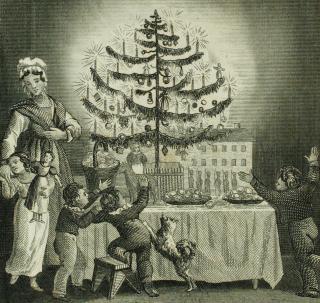Advertisement
Many congregations have venerated holiday traditions, but members of the Follen Church Society in Lexington, Massachusetts, can date theirs to 1832, when the Rev. Charles Follen (1796-1840) and his wife, Eliza, delighted party guests with something quite remarkable: a Christmas tree.
Born in Hesse-Darmstadt, Germany, Charles Follen lived an astoundingly full and varied life, influencing some of the most important social and religious movements of his time. As a student at the University of Giessen, he was at the center of a burgeoning nationalist movement, espousing individual rights and freedom. Follen was such an enthusiastic reformer that he was exiled to Switzerland, and eventually left for the United States, a place he referred to in a letter home as “the native land of freedom.”
He settled in Cambridge, Massachusetts, where he became Harvard’s first instructor in German, joined the elite circles of Boston’s intelligentsia, and trained as a Unitarian minister. He learned from members of the Transcendentalist Club, including Ralph Waldo Emerson, and influenced them too as he developed his own ideas of a free Christian church. He also became a fervent opponent of slavery. In 1828, he married Eliza Lee Cabot, an abolitionist and daughter of a prominent Boston family. A brief stint in New York ended when his abolitionist preaching rankled congregants and he returned to Massachusetts to serve a parish in the village of East Lexington.
But how did a man whose passions were religious freedom and the abolition of slavery come also to be known as the father of American Christmas trees? Like many traditions, this one hinges on a particularly well-told story.
The German tradition of Christmas trees had been seeded in the United States before that famed evening in the Follens’ parlor, but the sight of a tree indoors, festooned with decorations, was still captivatingly new. The Follens’ tree was nudged into history with the help of their friend and sister reformer, Harriet Martineau, who wrote about it in the popular magazine Godey’s Lady’s Book. Martineau could hardly find enough adjectives to describe the tree’s loveliness, and the children, she reported, were speechless: “All eyes wide open, all lips parted, all steps arrested.” Historians cite that tree, illuminated by Martineau’s write-up, among the first Christmas trees in the United States.
Follen died at just 44, in a steamship accident, while traveling home for the dedication of a building he had designed for his congregation. That octagonal structure is still in use by the Follen Church Society, a UU congregation of some 400 adults, children, and youth.
The congregation’s connection to Follen is kept alive in part through its annual Christmas tree sale, which began in the 1950s. “It’s a wonderful community-building event,” says longtime member Anne Engelhart. Each year, the youth group unloads nearly 900 trees off a truck from Calais, Maine, and a busy month begins. Kim Vandiver, who organizes the sale, said selling trees was his first activity as a newcomer in 1981 and still serves to connect members to each other and the community. Each tree the congregation sells bears a tag telling the buyer about the lineage of Follen Christmas trees, and the remarkable man with whom they are associated.
